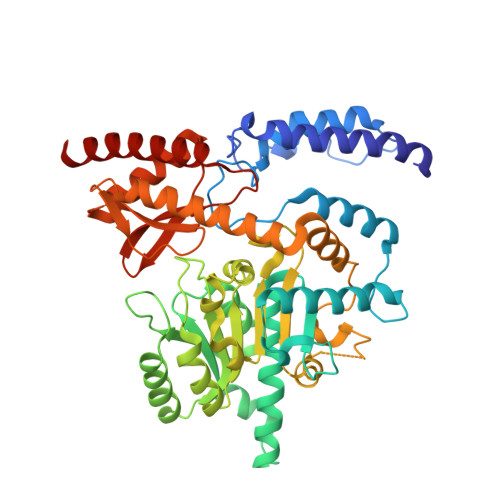Human aromatic amino acid decarboxylase is an asymmetric and flexible enzyme: Implication in aromatic amino acid decarboxylase deficiency.
Bisello, G., Ribeiro, R.P., Perduca, M., Belviso, B.D., Polverino De' Laureto, P., Giorgetti, A., Caliandro, R., Bertoldi, M.(2023) Protein Sci 32: e4732-e4732
- PubMed: 37466248
- DOI: https://doi.org/10.1002/pro.4732
- Primary Citation of Related Structures:
8OR9, 8ORA - PubMed Abstract:
Human aromatic amino acid decarboxylase (AADC) is a pyridoxal 5'-phosphate-dependent enzyme responsible for the biosynthesis of dopamine and serotonin, essential neurotransmitters involved in motor and cognitive abilities. Mutations in its gene lead to AADC deficiency, a monogenic rare neurometabolic childhood parkinsonism characterized by severe motor and neurodevelopmental symptoms. Here, for the first time, we solved the crystal structure of human holoAADC in the internal aldimine (1.9 Å) and in the external aldimine (2.4 Å) of the substrate analog L-Dopa methylester. In this intermediate, the highly flexible AADC catalytic loop (CL) is captured in a closed state contacting all protein domains. In addition, each active site, composed by residues of both subunits, is connected to the other through weak interactions and a central cavity. By combining crystallographic analyses with all-atom and coarse-grained molecular dynamics simulations, SAXS investigations and limited proteolysis experiments, we realized that the functionally obligate homodimeric AADC enzyme in solution is an elongated, asymmetric molecule, where the fluctuations of the CL are coupled to flexibility at the edge between the N-terminal and C-terminal domains. The structural integrity of this peripheral protein region is essential to catalysis, as assessed by both artificial and 37 AADC deficiency pathogenic variants leading to the interpretation that structural dynamics in protein regions far from the active site is essential for CL flexibility and the acquirement of a correct catalytically competent structure. This could represent the molecular basis for pathogenicity prediction in AADC deficiency.
- Department of Neuroscience, Biomedicine and Movement Sciences, Section of Biological Chemistry, Verona, Italy.
Organizational Affiliation:


















